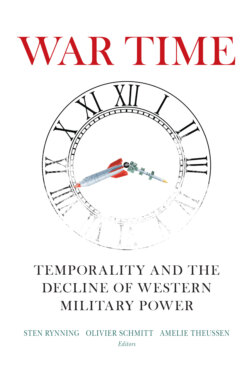Читать книгу War Time - Группа авторов - Страница 17
На сайте Литреса книга снята с продажи.
War and State Development
ОглавлениеThe Western way of war and state-making is unidirectional: war creates resource needs, which leads to extraction, which strengthens the central institutions of the state. Although scholars have observed variations in that relationship, for example, depending on whether the war is intrastate, interstate, or global,9 the prospect of variation over time has not been given serious consideration.10 And yet the nature of that longer-term relationship is important because of the impact and role of the public in a democracy as determined by its degree of sacrifice in the service of conflict. Since extraction—in other words, taxation—exerts pressures on the public, leaders who have turned to such fiscal coercion have provided accountability, whether through increased suffrage or veterans’ benefits after the war,11 or through responsiveness to public preferences in terms of the duration and conduct of the conflict itself. Conversely, the absence of extraction would mean no such reciprocal need to provide accountability.
Despite the typical characterization of a fairly simple relationship in which war creates revenue needs that give rise to extraction, its evolution has been far less linear. One view suggests that in earlier periods of conflict, revenue needs were limited by the nature of conflict and rudimentary technological innovation. Instead of relying on costly innovation, infantry units emphasized drill and de-emphasized battlefield heroics. Military units were, in a sense, “commodified” in that forces could be quickly raised and readily deployed so long as the soldiers were trained. As Hanson observes, militaries are ultimately a matter of economics, with states trying to achieve the most military power for the least cost.12 Infantry was far more efficient than cavalry, especially once the emergence of gunpowder allowed shooters to eviscerate horses.
Cicero famously noted that “the sinews of war are infinite money.” Money is never infinite, of course, and it certainly was more finite without significant extraction from the populace. Conquest and tribute—the protection money that a conquered land would pay to the conquerer—could only go so far; self-sustaining warfare required domestic revenue. Early states did engage in some degree of taxation but primarily indirect taxes such as on tea, salt, and linens.13 As Gerald Harriss remarks, “although the [British] Crown was actively exploiting its feudal and traditional taxes, and was extending them to meet the requirements of new military demands, none of these taxes adequately met its needs.”14 The limits to money therefore meant limits to war and militarism more broadly.
Another consequence was increasingly large piles of debt, which led to inefficiency, insofar as a dependence on credit meant servicing the debt through interest payments. The costs of war, as Geoffrey Parker notes, continued to mount dramatically without a concomitant rise in extraction.15 By the end of the American War of Independence, 66 percent of total tax revenues went toward servicing the debt. As debt increased, buying on credit became harder and more expensive. Yet the government had to generate additional revenues, which it did from additional indirect taxes such as customs, excise, or stamp duties.16
Debt and indirect duties, however, did not meaningfully engage the public. Writing around the time of high British debt in the eighteenth century, Adam Smith noted: “In great empires the people who live in the capital, and in the provinces remote from the scene of action, feel, many of them scarce any inconveniency from the war; but enjoy, at their ease, the amusement of reading in the newspapers the exploits of their own fleets and armies.”17 He advocated more visible costs of war—taxes rather than simply debt—to give people an incentive to want peace. Otherwise, the public would be “commonly dissatisfied with the return of peace, which puts an end to their amusement.” Public amusement is the antithesis of civic militarism, an apathy directly challenging the picture of citizen killers who ruthlessly killed and won wars.
Yet some early antecedents of public buy-in emerged. The poll tax in Europe was as brutally simple as it was ancient; hearth-tax equivalents, similarly, were common and had their own long history; land taxes were a routine tool in the hands of even pre-modern courts. However, increases in the “extensive” margin (that is, new taxes being enacted or brand new entrants added to the tax net) only occur at a glacial pace and are usually spurred by costly wars. States created parliaments to help collect these very taxes with some degree of consent.
Nonetheless, even these financing tools were inadequate in paying for war. Even the de jure elegance of poll taxes and hearth taxes often were in practice de facto “sub-national taxes”—taxes simply collected by cities, say, within a territory. By the time of the Early Modern era, Western states were usually characterized by rising costs, rising debts, and the resort to militarism on credit. Limits to money meant that, as David Parrott concludes, “the problem was above all of inadequate financial resources to pay or supply the armies … this served only to reveal the inherent technological and bureaucratic weaknesses of early modern states confronted with the burden of supporting armies 200–300,000 strong.”18 Financial technologies such as remittance banking, bonds, and currency exchanges emerged to finance involvement in conflict, but it took until the eighteenth century for central banks and bonds to emerge as viable sovereign financing tools, and whether expensive or cheap, debt had now “accelerated” into a situation of being ubiquitous, sophisticated, and crucial to war financing, yet ultimately limiting in terms of the militaristic reach.
